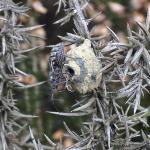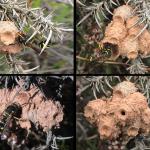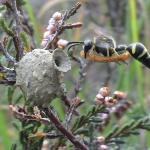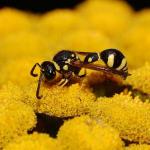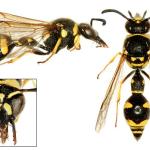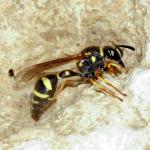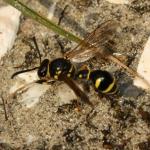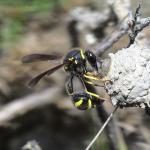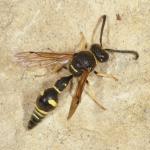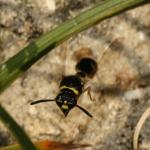Identification keys and general biology are given in Olberg (1959), Spradbery (1973), Richards (1980), Falk (1991), Yeo & Corbet (1995) and Archer (2000). This species is known as the Heath Potter Wasp.
A mating couple, followed by a female collecting mud and building her pot - about 25 balls of mud are used and it takes between 2-3 hours to complete. A single egg is laid inside the pot. Video by John Walters Timelapse of heath potter wasp Eumenes coarctatus building its second pot. Bovey Heath Devon September 2014. Video by John Walters Timelapse of a heath potter wasp Eumenes coarctatus building a pot - this wasp has been coloured marked PINK YELLOW as part of John's extensive study of this wasp. After laying the egg the female wasp hunts for caterpillars and collects up to 38 to provision the pot. When full she collects a ball of mud and seals the entrance, she gives the pot a final check before flying away. Each female builds about 10 pots in her lifetime. Video by John Walters
From South Devon to East Sussex, and north to Buckinghamshire. There are historic records from West Cornwall, Wiltshire and Glamorgan.
Overseas found in many parts of Europe (Sweden, Finland, The Netherlands, Luxembourg, France, Spain, Portugal, Malta, Germany, Switzerland, Poland, Austria, Hungary, former Yugoslavia, Albania, Greece, Romania, Bulgaria) and Georgia and far-eastern Russia.
Listed as Notable A by Falk (1991) (now known as Nationally Scarce Na).
Heathlands with patches of exposed clay soil (quarry sites) and sources of water, e.g. ponds, streams and bogs. Nests (pots) are constructed on heather, gorse and occasionally dead grass stems.
Flies from late April to mid-October with most records from late May to mid-September. Pots built before the end of June produce a partial second brood. Males are most frequently seen in May and June and again in July and August if conditions have been favourable to produce a second brood.
Small lepidopterous larvae, mainly geometrids and tortricids. Geometrid larvae are favoured, especially pug moth larvae which feed on the flowers of heather and gorse; species identified include Double-striped Pug Gymnoscelis rufifasciata (Haworth), Narrow-winged Pug Eupithecia nanata (Hübner), Horse Chestnut Pachynemia hippocastanaria (Hübner) and Grass Emerald Pseudoterpna pruinata (Hufnagel).
After mating the female selects a source of water and a quarry site for clay, which she uses for the construction of all her pots. If the water source dries out during the summer she will select another. Nest construction begins with the female visiting the quarry and water source. She does not collect soil but will land and test the soil with her mouthparts. She then flies slowly through the vegetation stopping occasionally to test the stems of heathers, gorse and grass stems for suitability as a nest site. When a site is selected the wasp spends a few minutes working at the point that the first mud will be placed with her mouthparts, cleaning the surface; she sometimes wets the stem to enable her to remove loose material. She then collects water and returns to the quarry. Water is added to the dry clay soil to form a small ball of mud that is held in the jaws and forelegs. This is carried to the nest site where building commences. Nest sites range between 0.5 and 126 metres from the quarry with most between 20 and 40 metres away The wasp usually flies 1–2 metres above the ground but in very warm conditions she will fly at a height of 15–20 metres. Each pot takes 1.5–3 hours to build in optimum conditions but nest construction is often delayed by bad weather and can take several days to complete. Between 22 and 28 balls of clay are used to construct each pot. During construction the wasp will replenish her water supply after about every two visits to the quarry. When the soil at the quarry is damp after rain the wasp will collect mud directly from the quarry without visiting the water source. When the pot is completed the wasp will sit in vegetation near the pot for a few minutes before returning to lay a single egg in it. Egg laying takes about 2 minutes. The egg is suspended by a short strand of silk from the wall of the pot. Egg laying may be delayed until the following morning if the pot is completed very late in the day. The egg hatches after about 3 days. The wasp then hunts for caterpillars and have been observed searching on heather and gorse flowers. The caterpillar is pulled from its hiding place and stung several times. Then it is passed through the jaws and each segment bitten lightly. The wasp then holds the caterpillar in her jaws and first two pairs of legs and flies to the pot. The caterpillar is pushed in using the jaws and forelegs. Between nine and 38 caterpillars are used to provision a pot. The wasp usually returns to the pot with a caterpillar about once an hour. If a good hunting-ground is found the wasp will return to it several times in quick succession. Provisioning usually takes 2–3 days but can be completed in 3.5 hours if conditions are favourable. In unfavourable conditions provisioning can take a week or more. If bad weather prevents provisioning, the Eumenes larva may die and the pot fail. The pot may also fail due to parasitism, e.g. by the sarcophagid fly Amobia signata (Meigen). The wasp frequently inserts her antennae in the pot entrance during the provisioning stage. If the larva has died, provisioning ceases and the wasp returns to the quarry to select a new site.
When the pot is full the wasp returns to the water source before collecting a small ball of clay to seal the entrance. Occasionally two balls of clay are used. The wasp then checks the outside of the pot with her antennae. The wasp often flies away from the pot and returns to check its surface several times before finally leaving it. Occasionally a second pot is attached to the first. Higher multiples of 3-8 have been recorded. Multiples of 3 or more are almost always built during September and early October. Presumably time is saved by cutting out the searching phase at this time of year. During her lifetime, which usually lasts for 2–3 months, a female builds and provisions about 25 pots.
The Eumenes larva consumes the prey in about a week. If the pot is built before the end of June the larva will pupate immediately and emerge about 2–3 weeks later. Some pots built in early July (up to 11th in south Devon) may also emerge in the same year. Otherwise the full-grown larva will remain unchanged through the winter and pupate in April or May.
Angelica, bramble, dwarf elder, western gorse, heather and heaths, alder buckthorn.
Spradbery (1973) quotes Chrysis ignita (Linnaeus) and several ichneumonid species from a nineteenth century German paper (Ratzeburg, 1852). The fly Amobia signata and the ichneumon wasp Gelis meigenii (Förster) have been recorded at a site in South Devon. The cryptine ichneumonid Acroricnus stylator (Thunberg) is a specialist parasitoid of Eumenes. Small parasitic wasps have been found in pots which have emerged from caterpillars parasited before being caught by Eumenes.
November 2014


